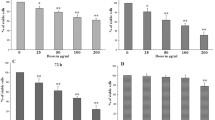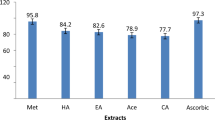Abstract
In this work biological effects of two common kinds of green tea (Chinese Gunpowder and Japanese Sencha) were analyzed using three independent tests of antimutagenicity: 1) the Ames test with Salmonella typhimurium TA98, 2) cytogenetic analysis of peripheral blood lymphocytes (CAPL), and 3) test with Saccharomyces cerevisiae D7. Tea extracts were allowed to be antimutagenic based on their ability to inhibit the mutagenic effect of standard mutagens. Amounts of (−)catechin and (−)catechin gallate in tea extracts were determined by high performance liquid chromatography on reversed phase (RP-HPLC). Antioxidant capacity was found using total radical-trapping antioxidant parameter (TRAP) method. Extracts from Gunpowder and Sencha exhibited high antimutagenic activity in the Ames test (24.7± 3.7% and 34.1± 2,1% of inhibition without metabolic activation; 74.9± 1.7% and 62.7± 4.3% of inhibition with metabolic activation, respectively) as well as in S. cerevisiae D7 test (Gunpowder: 62.7± 5.7% of Trp convertants inhibition and 52.6± 5.3% of Ilv revertants inhibition; Sencha: 45.6± 4.2% of Trp convertants inhibition, 50.0± 4.8% of Ilv revertants inhibition). In the CAPL method reduced number of abberant cells as well as decreased number of chromosome breaks was observed using both green tea extracts. Antioxidant capacity and antimutagenicity of green tea extracts was higher than activity of tea catechins and flavonoids.
Similar content being viewed by others
References
Roy M, Chakrabarty S, Sinha D, Bhattacharya RK, Siddiqi M (2003) Anticlastogenic, antigenotoxic and apoptotic activity of epigalokatechin gallate: A green tea polyphenol. Mutat Res 523–524: 33–41.
Bronzetti G (1994) Antimutagens in food. Trends Food Sci Technol 5: 390–395.
Namiki M (1990) Antioxidants/antimutagens in food. Food Sci Nutr 2: 273–300.
Katiyar SK, Mukhtar H (1996) Tea in chemoprevention of cancer: Epidemiologic and experimental studies. Int J Oncol 8: 221–238.
Roy M, Siddiqi RK, Bhattacharya RK (2001) Cancer chemoprevention: Tea polyphenol induced cellular and molecular responses. Asian Pacific J Cancer Prev 2: 109–116.
Dhawan A, Anderson D, de Pascual-Teresa S, Santos-Buelga C, Clifford MN, Ioannides C (2002) Evaluation of the antigenotoxic potential of monomeric and dimeric flavanols, and black tea polyphenols against heterocyclic amine-induced DNA damage in human lymphocytes using the Comet assay. Mutat Res 515: 39–56.
Wang H, Provan GJ, Helliwell K (2000) Tea flavonoids: Their functions, utilisation and analysis. Trends Food Sci Technol 11: 152-160.
Merken HM, Beecher GR (2000) Measurement of food flavonoids by high-performance liquid chromatography. J Agric Food Chem 48: 577–599.
Slavikova H, Lojek A, Hamar J, Duskova M, Kubala L, Vondracek J, Ciz M (1998) Total antioxidant capacity of serum increased in early but not late period after intestinal ischemia in rats. Free Rad Biol Med 25: 9–18.
Beudot C, De Méo MP, Dauzonne D, Elias R, Laget M, Guiraud H, Balansard G, Duménil G (1998) Evaluation of the mutagenicity and antimutagenicity of forty-two 3-substituted flavones in the Ames test. Mutat Res 417: 141–153.
Wall ME, Wani MC, Hughes TJ, Taylor H (1988) Plant antimutagenic agents 1.General bioassay and isolation procedures. J Nat Prod 51(5): 866–873.
Zimmermann FK, von Borstel RC, von Halle ES, Parry JM, Siebert D, Zetterberg G, Barale R, Loprieno N (1984) Testing of chemicals for genetic activity with Saccharomyces cerevisiae. Mutat Res 133: 199–244.
Lambert JD, Yang ChS (2003) Cancer chemopreventive activity and bioavailability of tea and tea polyphenols. Mutat Res 523–524: 201–208.
Jodoin J, Demeule M, Beliveau R (2002) Inhibition of the multidrug resistance P-glycoprotein activity by green tea polyphenols. Biochim Biophys Acta 1542(1–3): 149–159.
Simic D, Vukovic-Gacic B, Knezevic-Vukcevic J (1998) Detection of natural bioantimutagens and their mechanisms of action with bacterial assay-system. Mutat Res 402: 51–57.
Kuroda Y, Hara Y (1999) Antimutagenic and anticarcinogenic activity of tea polyphenols. Mutat Res 436: 69–97.
Ito Y, Ohnishi S, Fujie K (1989) Chromosome aberrations induced by aflatoxin B1 in rat bone marrow cells in vivo and their suppression by green tea. Mutat Res 222: 253–261.
Han C (1997) Screening of anticarcinogenic ingredients in tea polyphenols. Cancer Lett 114: 153–158.
Johnson MK, Loo G (2000) Effect of epigallocatechin gallate and quercetin on oxidative damage of cellular DNA. Mutat Res 459: 211–218.
Ohe T, Marutani K, Nakase S (2001) Catechins are not major components responsible for anti-genotoxic effects of tea extracts against nitroarenes. Mutat Res 496: 75–81.
Author information
Authors and Affiliations
Corresponding author
Rights and permissions
About this article
Cite this article
Bunkova, R., Marova, I. & Nemec, M. Antimutagenic Properties of Green Tea. Plant Foods Hum Nutr 60, 25–29 (2005). https://doi.org/10.1007/s11130-005-2539-7
Issue Date:
DOI: https://doi.org/10.1007/s11130-005-2539-7




